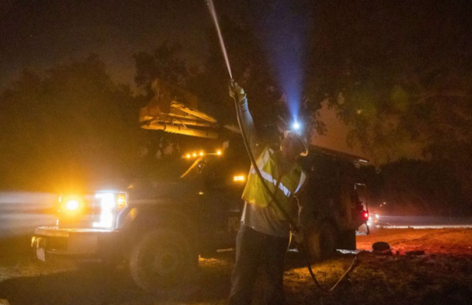These preventative shutdowns come as the PG&E faces new legal woes.
Pacific Gas & Electric warned tens of thousands of customers in California that their power may be shut off to help prevent wildfires due to severe wind and drought conditions in the area.
The preemptive shutdowns, at the inconvenience of customers, come as the company is still reeling from fallout related to deadly blazes in 2018 and 2020 authorities say were sparked by trees hitting the power grid. They also come as climate change has exacerbated California’s wildfires, stoking conditions experts say have led to the larger and deadlier blazes seen in recent years.
The company sent shutoff warnings to nearly 44,000 customers spanning 22 counties — including Alameda, Fresno and Napa — in northern and central California on Sunday.
PG&E updated on its website that shutoffs were required and its map of outages indicated power had been temporarily turned off in a slew of communities in the state’s Northern Sierra Foothills region, North Coast region and beyond.
PG&E meteorologists have been tracking a weather system, which is expected to bring wind gusts of up to 50 mph,” the company said in a statement. “PG&E’s in-house meteorologists, its Wildfire Safety Operations Center and its Emergency Operations Center continue to monitor conditions closely.”
Customers impacted were notified via text, email and automated phone calls beginning Saturday, the company said. More information on the latest status in specific neighborhoods can be found on PG&E’s website, along with tips for customers on how to prepare for the planned outages — such as unplugging appliances and using battery-powered flashlights.
Counties that would likely see the most customers impacted include Tehama customers, they were sent warnings, Solano customers and Lake customers. PG&E initially said it expects “minimal impact” to be felt by customers in the Bay Area and Central Valley.
The National Weather Service has warned of high winds in California due to a powerful storm in the west bringing a “critical fire weather” warning in central and northern California through Tuesday.
The so-called Public Safety Power Shutoffs (PSPS), which proactively turn off power in an effort to reduce the risk of wildfire from energized power lines, come as California has been battling larger and deadlier blazes in recent years linked to climate change.

The preemptive power shutdowns also come as PG&E has been embroiled in controversy linked to the wildfires. Late last month, the company was charged with involuntary manslaughter and other counts related to the 2020 Zogg Fire, which was sparked by a tree contacting a PG&E electric line.
PG&E CEO Patti Poppe disputed the criminal charges in a statement shortly after they were announced, saying, “We’ve accepted CAL FIRE’s determination, reached earlier this year, that a tree contacted our electric line and started the Zogg Fire. We accept that conclusion. But we did not commit a crime.”
“This was a tragedy, four people died. And my coworkers are working so hard to prevent fires and the catastrophic losses that come with them. They have dedicated their careers to it, criminalizing their judgment is not right,” Poppe added.
The latest legal action taken against the firm comes after the company pleaded guilty last year to 84 counts of involuntary manslaughter and one count of unlawfully starting a fire for its link to the ignition of the devastating 2018 Camp Fire.
In her statement, Poppe noted steps the firm is taking to prevent wildfires, saying it is investing more than $1.4 billion in 2021 alone in vegetation management, removing 300,000 trees and trimming a million more, working toward burying 10,000 miles of power lines and more.
Source: ABC NEWS, Catherine Thorbecke
Image credits, AP, FILE, Reuters










